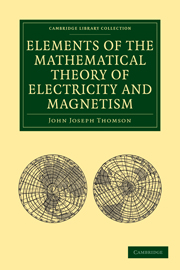Book contents
- Frontmatter
- PREFACE TO FIRST EDITION
- PREFACE TO THE SECOND EDITION
- PREFACE TO THE THIRD EDITION
- PREFACE TO THE FOURTH EDITION
- Contents
- CHAP. I General Principles of Electrostatics
- CHAP. II Lines of Force
- CHAP. III Capacity of Conductors. Condensers
- CHAP. IV Specific Inductive Capacity
- CHAP. V Electrical Images and Inversion
- CHAP. VI Magnetism
- CHAP. VII Terrestrial Magnetism
- CHAP. VIII Magnetic Induction
- CHAP. IX Electric Currents
- CHAP. X Magnetic Force due to Currents
- CHAP. XI Electromagnetic Induction
- CHAP. XII Electrical Units: Dimensions of Electrical Quantities
- CHAP. XIII Dielectric Currents and the Electromagnetic Theory of Light
- CHAP. XIV Thermoelectric Currents
- CHAP. XV The Properties of Moving Electric Charges
- INDEX
CHAP. XII - Electrical Units: Dimensions of Electrical Quantities
Published online by Cambridge University Press: 07 September 2010
- Frontmatter
- PREFACE TO FIRST EDITION
- PREFACE TO THE SECOND EDITION
- PREFACE TO THE THIRD EDITION
- PREFACE TO THE FOURTH EDITION
- Contents
- CHAP. I General Principles of Electrostatics
- CHAP. II Lines of Force
- CHAP. III Capacity of Conductors. Condensers
- CHAP. IV Specific Inductive Capacity
- CHAP. V Electrical Images and Inversion
- CHAP. VI Magnetism
- CHAP. VII Terrestrial Magnetism
- CHAP. VIII Magnetic Induction
- CHAP. IX Electric Currents
- CHAP. X Magnetic Force due to Currents
- CHAP. XI Electromagnetic Induction
- CHAP. XII Electrical Units: Dimensions of Electrical Quantities
- CHAP. XIII Dielectric Currents and the Electromagnetic Theory of Light
- CHAP. XIV Thermoelectric Currents
- CHAP. XV The Properties of Moving Electric Charges
- INDEX
Summary
255. In Art. 9 we defined the unit charge of electricity, as the charge which repelled an equal charge with unit mechanical force when the two charges were at unit distance apart and surrounded by air at standard temperature and pressure. When we know the unit charge the various other electrical units easily follow. Thus the unit current is the one that conveys unit charge in unit time; unit electric intensity is that which acts on unit charge with unit mechanical force; unit difference of potential is the potential between two points when unit work is done by the passage of unit charge from one point to the other. Unit resistance is the resistance between two points of a conductor between which the potential difference is unity when the conductor is traversed by unit current.
The step from the electrical to the magnetic quantities is made by means of the law that the work done when unit magnetic pole is taken round a closed circuit is equal to 4π times the current flowing through the circuit. This law is to some extent a matter of definition. All that is shown by experiment is that the work done when unit pole is taken round the circuit is proportional to the current flowing through the circuit, and, as long as the current remains the same, is independent of the nature of the substances passed through by the pole in its tour round the circuit.
- Type
- Chapter
- Information
- Elements of the Mathematical Theory of Electricity and Magnetism , pp. 457 - 479Publisher: Cambridge University PressPrint publication year: 2009First published in: 1895



